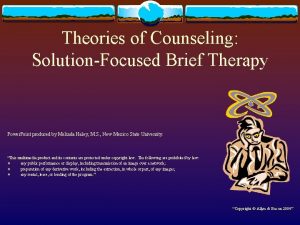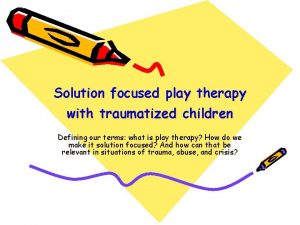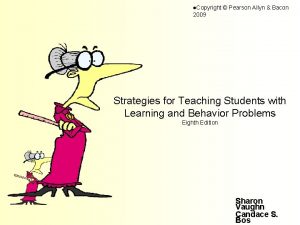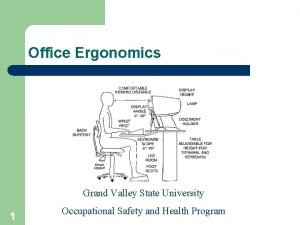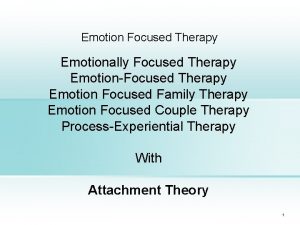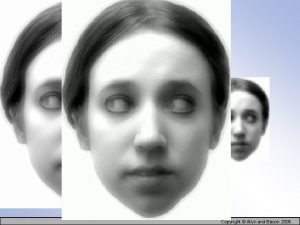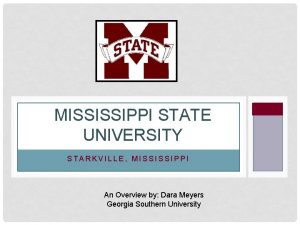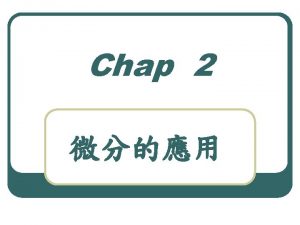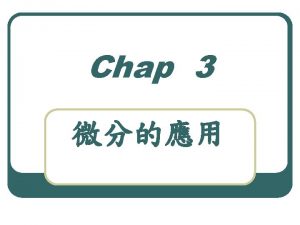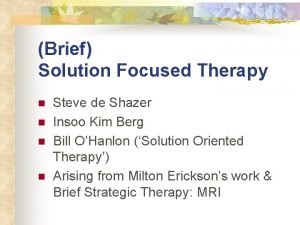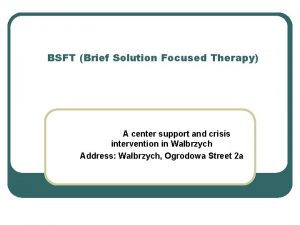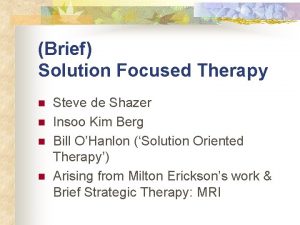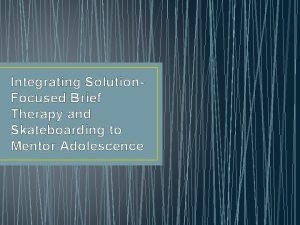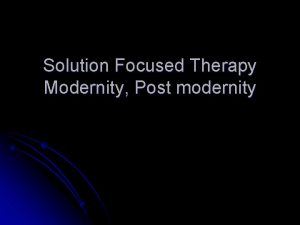Solution focused Therapy Allyn Flemmons Mississippi State University


















- Slides: 18

Solution focused Therapy Allyn Flemmons Mississippi State University

Solution Focused The Basics Change is Constant Positive > Negative Future is Negotiable Time Sensitive

History of Solution Focus Founded by Eve Lipchik, Steve de Shazar, & Insoo Kim Berg. 1980 s to 1990 s, Lipchik, Insoo and de Shazar began to move the Mental Research Institute models toward Solution Focused approaches. A. K. A. What is working, and not on what has NOT been working. (Bitter, 2009)

History of Solution Focus Began their work in the Brief Family Therapy Center (BFTC). Others leaders at this center include Scott Miller, John Walter, Jane Peller, Michele Weiner-Davis. BFTC later closed its doors after the deaths of the leading Clinicians, Insoo and de Shazar. (Bitter, 2009)

Solution Focused Three Rules: As stated by Stephen Langer, 1. If it isn’t broken, don’t fix it. 2. If it works, do more of it. 3. If it is not working, do something different. (Langer)

Why Solution Focus? It helps therapist see where the client wants to go, instead of assuming they need to grieve, deal with anger, etc. It allows the client to leave their problem saturated world for a moment to a moment of freedom. May also provide clarity through this.

Solution Focused “MECSTAT” Miracle questions Exception questions Coping questions Scaling questions Time-out Accolades and Task (Hamada, Martin & Batty, 2006) Miracle, Exception, and Scaling Questions are known as “Questions of Difference. ” (Bitter, 2009)

Miracle Question “Imagining an ideal future and connecting it to the present immediately actualizes the work. Clients are challenged to look past their obstacles and hopelessness and focus on the possibilities” (Howes, 2010). Examples: Suppose tonight, while you slept, a miracle occurred. When you awake tomorrow, what would be some of the things you would notice that would tell you life had suddenly gotten better? " (Howes, 2010)

Exception Question Are there times when the problem does not happen? When was this? What was different? How did you make that happen? ” • There will always have been situations in which the problem was less intense and when things were better. • Analyzing these times can sometimes help solve the client’s problem. (Visser, 2011)

Coping Question Often used when Problem Solving questions no longer work. By using the coping question clients are helped to become aware that they in fact are managing, at least to some extent. Examples • What helps you to keep going even though things are really hard? • It is admirable how you have been able to keep on going under such difficult circumstances. . how did you do that? (Visser, 2011)

Scaling Question Used to help clients gauge their current condition. On a Scale of 1 to 10, how are you feeling this week? (Visser, 2011)

Time-Out The latter half of the session, the Counselor may summarize what has been talked about so far. Peter De Jong and Insoo Kim Berg: 1) The summary reassures the client that the SF practitioner was listening. 2) The summary reassures the SF practitioner that he has heard the client accurately. 3) By using the client's words in the summary the SF practitioner shows respect for the client's frame of reference. 4) The summary (if done descriptively and in a spirit of openness) has the effect of inviting the client to say more. 5) The summary has the effect of putting the client in control of how to describe their experiences. 6) The summary assists the SF practitioner in formulating the next question based on what the client has just revealed

Accolades and Task Accolades= Compliments. Tasks= Homework. Accolades help encourage client and foster client/counselor relationship. Homework can be tasks that the client has used before that work. OR Tasks a client has NOT tried but WANTS to try.

SFBT Clients Visitor I don’t need help, I’m not the problem. COMPLIMENTS Are most helpful here. (De. Shazer) 3 Types: Complaint We need help, but someone else is Customer We need help, We are both the problem. responsible to fix it. Compliments to encourage return. Homework to focus where they are responsible for others actions. Compliment. But focus on homework to highlight exceptions and strengths. (“Solution Focused Therapy”, Psych. Page)

Why SFBT? • It’s multiculturally friendly. • Works with most age groups. • Particularly beneficial in a school system. (3 -5 sessions) • Lends itself to individuals suffering mental illness diagnosis, such as Schizophrenia, Depression, Anxiety. (Langer)

Problems with SFBT Tendency to overlook the negative which the client may need to address. Does not appear to be beneficial for external illnesses such as hyperactivity or Conduct Disorder.

Solution Focused Interventions Look for previous solutions, strengths, resources and abilities. Exceptions. (What happened when you did something different? ) Questions. Present and future orientation. Compliments. Encouragement to do what’s working. (Langer)

• References Bitter, J. (2009). Theory and practice of family therapy and counseling. Belmont, CA. : Brooks/Cole. Hamada, H. , Martin, D. , & Batty, H. (2006). Adapting an effective counseling model from patient-centered care to improve motivation in clinical training programs. Med Educ. Retrieved from Available from http: //www. med-ed-online. org Howes, R. (2010, January 18). Cool intervention #10: The Miracle Question. Retrieved from http: //www. psychologytoday. com/blog/in -therapy/201001/cool-intervention-10 -the-miracle-question Langer, S. (n. d. ). What is it and what's the difference? . Retrieved from http: //casat. unr. edu/docs/Stephen. Langer_Solution. Focused. Brief. Therapy. pdf Solution focused therapy. Pyschpage. Retrieved from http: //www. psychpage. com/family/library/sft. htm Visser, C. (2011, July 3). 21 solution focused techniques. Retrieved from http: //solutionfocusedchange. blogspot. com/2011/07/21 solution-focused-techniques. html
 Solution focused therapy powerpoint
Solution focused therapy powerpoint Solution focused therapy youtube
Solution focused therapy youtube Solution focused play therapy
Solution focused play therapy Mississippi state university library
Mississippi state university library Ari allyn-feuer
Ari allyn-feuer Allyn harter
Allyn harter Allyn & bacon
Allyn & bacon Allyn & bacon
Allyn & bacon Allyn and bacon publishing
Allyn and bacon publishing Eft cycle
Eft cycle Compassion focused therapy
Compassion focused therapy Linda metcalf solution focused
Linda metcalf solution focused Cleveland state occupational therapy
Cleveland state occupational therapy Grand valley occupational medicine
Grand valley occupational medicine Mississippi state plane zone map
Mississippi state plane zone map The united states east of the mississippi river
The united states east of the mississippi river Gulfport port authority
Gulfport port authority Both psychoanalysis and humanistic therapy stress
Both psychoanalysis and humanistic therapy stress Bioness integrated therapy system price
Bioness integrated therapy system price
